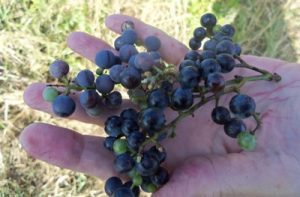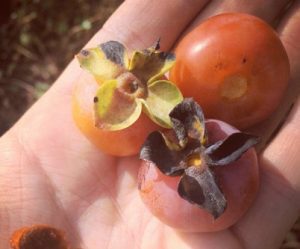Aronia berries are one of those superfoods, chock full of antioxidants and other health benefits thanks to their dark coloring. But they weren’t a commercial crop until the 1990s, though processed drinks already contained the fruit, which means that the health drink maker was sourcing them in the wild. Foraged food in a grocery store way back when!

Red Aronia Berries
How and why Sawmill Valley Farm became the first commercial grower of aronia berries is an interesting story. Many will marvel at their path to becoming leaders in emerging superfoods crops, cheer their decision to grow organic berries, and attend their annual Aronia Berry Festival agritourism event. Thousands do every year, eager to check out unique products rich in phytonutrients. But a grower might start pondering the same things I did.
They decided to try growing aronia berries for several reasons. Not only did being the only farm producing them present a waiting market without competition sound enticing, but they offered a sustainable agriculture solution for a challenging piece of farmland. The plants are also perennials that offered a crop that would stop the heavy erosion that Iowa soils are so prone to. And last, but not least, these native plants have no pests or diseases, making growing without organic pesticides and fertilizer inputs a piece of cake.

The question that begs answering… what other native plants are superfoods? It turns out there’s quite a list to consider, and though many are already grown commercially, they aren’t the original. Today’s hybridized, commercial versions – bred for increased sugar content, shipping ease, shelf life, and super-sized fruits – offer reduced nutrition from high maintenance, needy crops. For instance, according to Web MD, 1 cup of wild blueberries offers a total antioxidant capacity of 13,427, while commercially cultivated blueberries have only 9,019. Bigger fruits give you less skin per pound, the source of phytonutrients, which makes their smaller parents superior super fruits. And that increased phytochemical and antioxidant content also make plants less prone to pests and disease. So, organic cultivation in the backyard garden or market farm becomes far easier – as long as it’s native to the area.
FRUITING NATIVE SUPERFOODS
- Wild Grapes (benefits: leaves & fruit)
- Wild Cranberries (health benefits)
- Wild Blackberries (health benefits)
- Wild Raspberries (health benefits)
- Wild Salmonberries (health benefits)
- Wild Blueberries (health benefits)
- Wild Saskatoon/Serviceberries (health benefits)
- Native American Persimmons (health benefits)
- Wild Elderberries (health benefits)
- American Paw Paw: not papayas (health benefits)
- Wild Aronia Berries: red, purple, and black (polyphenols)
Some of these super fruits grow in the wild all over North America, and others are confined to certain portions or regions. And the price of seed and starter plant cuttings or divisions? Free.
 Consider the phrase, “Grow where you’re planted.” That’s what native plants do in the wild, though they thrive only in the right soil and climate conditions to fit their needs. Harnessing those strengths in cultivation offers the smarter approach to sustainable agriculture than forcing exotic crops to grow in alien conditions.
Consider the phrase, “Grow where you’re planted.” That’s what native plants do in the wild, though they thrive only in the right soil and climate conditions to fit their needs. Harnessing those strengths in cultivation offers the smarter approach to sustainable agriculture than forcing exotic crops to grow in alien conditions.
Cultivating native plants certainly, makes the organic grower’s job easier. And in the end, you’ve got the one true food from which the others came, original superfoods that aren’t just environmentally friendly, but can protect and/or restore the soil they’re grown on.
Choosing the right native plants makes no-till forest farming the proper approach to food production beyond mushrooms. So much for importing exotics across oceans to get superfoods’ benefits. We’ve got plenty of those, long forgotten or ignored, right here on the North American continent.
More Info:
Images courtesy of Canadian Wild Blueberries, FloraFinder, Along The Grapevine, and Return To Nature (respectively).